- Home
- Susan Wittig Albert
Dead Man's Bones
Dead Man's Bones Read online
Table of Contents
Title Page
Copyright Page
Chapter One
Chapter Two
Chapter Three
Chapter Four
Chapter Five
Chapter Six
Chapter Seven
Chapter Eight
Chapter Nine
Chapter Ten
Chapter Eleven
Chapter Twelve
Chapter Thirteen
Chapter Fourteen
Chapter Fifteen
Chapter Sixteen
Chapter Seventeen
Chapter Eighteen
Chapter Nineteen
Chapter Twenty
Chapter Twenty-one
Herbs for Your Skeleton
Reading Resources
A Collection of Recipes from Dead Man’s Bones
About the Author
Susan Wittig Albert’s exciting mysteries have been praised as “unique” (Seattle Post-Intelligencer) and “fascinating” (Booklist). Now, a dead man’s bones are uncovered—and Texas ex-lawyer and herbalist China Bayles must dig into a pair of murders separated by time but connected by motive . . .
When China’s teenage son finds some skeletal remains during a local cave dig—remains that show a not-so-accidental death—it’s a disturbing development. But China doesn’t let it distract her from the opening of the new community theater donated by the elderly Obermann sisters. Unfortunately, the haughty, bullying Jane Obermann—and her frail, frightened younger sister—made the donation with a condition: that the first production be a play written by Jane about their aristocratic family history.
The premiere party ends with a bang when a ne’er-do-well local handyman is shot dead by Jane while breaking into the Obermann estate. It seems like a clear-cut case of self-defense. But China senses something else going on behind the scenes. Now, the key to catching a killer might be the mysterious bones in the cave—a clue from the past that could help China solve a mystery in the present . . .
“ONE OF THE MOST ENDEARING AND PERSONABLE AMATEUR SLEUTHS.”
—Midwest Book Review
“SUCH A JOY . . . AN INSTANT FRIEND.”
—Carolyn G. Hart
Acclaim for Susan Wittig Albert’s Dead Man’s Bones . . .
“China’s warmth and sensitivity . . . will endear her to readers, while her investigative skills make her a leader among female sleuths. Fascinating information about herbs and tempting recipes round out this leisurely cozy with a Southwestern flair.” —Publishers Weekly
“China Bayles is always trying to teach us stuff: it’s not annoying at all but somehow soothing and fascinating . . . An enjoyable journey.” —Booklist
A Dilly of a Death . . .
“More than just a whodunit . . . readers will relish this more-sweet-than-sour adventure.” —Booklist
“Add another fragrant bloom to the dozen already in the bouquet of Albert’s herbal cozies.” —Publishers Weekly
Indigo Dying . . .
“Albert’s skill in weaving everything together into a multilayered whole makes the reading smooth, interesting, and enjoyable.” —San Antonio Express-News
“Accomplished . . . The heart of the book is the detailed depiction of small-town life in Indigo, which separates the novel from genre fodder by providing a rich context for the mystery. The satisfying ending is icing on the cake.”
—Publishers Weekly
Bloodroot . . .
“Albert has created captivating new characters and a setting dripping with atmosphere.” —Publishers Weekly
Mistletoe Man . . .
“Ms. Albert artfully uses Texas language patterns to bring the down-home town of Pecan Springs alive with eccentrics in abundance.” —The Dallas Morning News
“Breezy ... The characters are an appealing bunch . . . Albert also provides lots of interesting lore about mistletoe . . . A nice book to curl up with on a blustery day, perhaps with a cup of Christmas tea.” —Chicago Tribune
“The pace is as peppy as a Texas two-step, Albert’s dialogue and characterizations put her in a class with lady sleuths V. I. Warshawski and Stephanie Plum, and her writing sparkles.” —Publishers Weekly (starred review)
Praise for the China Bayles mystery series . . .
“[China Bayles is] such a joy . . . an instant friend.”
—Carolyn G. Hart
“A treat for gardeners who like to relax with an absorbing mystery.” —North American Gardener
“One of the best-written and well-plotted mysteries I’ve read in a long time.” —Los Angeles Times
“Albert’s characters are as real and as quirky as your next-door neighbor.” —The Raleigh News & Observer
“Mystery lovers who also garden will be captivated by this unique series.” —Seattle Post-Intelligencer
“Realistic, likable characters.” —Chicago Tribune
“Lively and engaging.” —Fort Worth Star-Telegram
“Gripping.” —Library Journal
“Cause for celebration.” —Rocky Mount (NC) Telegram
China Bayles Mysteries by Susan Wittig Albert
THYME OF DEATH
WITCHES’ BANE
HANGMAN’S ROOT
ROSEMARY REMEMBERED
RUEFUL DEATH
LOVE LIES BLEEDING
CHILE DEATH
LAVENDER LIES
MISTLETOE MAN
BLOODROOT
INDIGO DYING
AN UNTHYMELY DEATH
A DILLY OF A DEATH
DEAD MAN’S BONES
With her husband, Bill Albert, writing as Robin Paige
DEATH AT BISHOP’S KEEP
DEATH AT GALLOWS GREEN
DEATH AT DAISY’S FOLLY
DEATH AT DEVIL’S BRIDGE
DEATH AT ROTTINGDEAN
DEATH AT WHITECHAPEL
DEATH AT EPSOM DOWNS
DEATH AT DARTMOOR
DEATH AT GLAMIS CASTLE
DEATH IN HYDE PARK
DEATH AT BLENHEIM PALACE
DEATH ON THE LIZARD
Beatrix Potter Mysteries by Susan Wittig Albert
THE TALE OF HILL TOP FARM
THE TALE OF HOLLY HOW
Nonfiction books by Susan Wittig Albert
WRITING FROM LIFE
WORK OF HER OWN
THE BERKLEY PUBLISHING GROUP
Published by the Penguin Group
Penguin Group (USA) Inc.
375 Hudson Street, New York, New York 10014, USA
Penguin Group (Canada), 90 Eglinton Avenue East, Suite 700, Toronto, Ontario M4P 2Y3, Canada
(a division of Pearson Penguin Canada Inc.)
Penguin Books Ltd., 80 Strand, London WC2R 0RL, England
Penguin Group Ireland, 25 St. Stephen’s Green, Dublin 2, Ireland (a division of Penguin Books Ltd.)
Penguin Group (Australia), 250 Camberwell Road, Camberwell, Victoria 3124, Australia
(a division of Pearson Australia Group Pty. Ltd.)
Penguin Books India Pvt. Ltd., 11 Community Centre, Panchsheel Park, New Delhi—110 017, India
Penguin Group (NZ), Cnr. Airborne and Rosedale Roads, Albany, Auckland 1310, New Zealand
(a division of Pearson New Zealand Ltd.)
Penguin Books (South Africa) (Pty.) Ltd., 24 Sturdee Avenue, Rosebank, Johannesburg 2196,
South Africa
Penguin Books Ltd., Registered Offices: 80 Strand, London WC2R 0RL, England
This is a work of fiction. Names, characters, places, and incidents either are the product of the author’s imagination or are used fictitiously, and any resemblance to actual persons, living or dead, business establishments, events, or locales is entirely coincidental. The publisher does not
have any control over and does not assume any responsibility for author or third-party websites or their content.
PUBLISHER’S NOTE: The recipes contained in this book are to be followed exactly as written. The publisher is not responsible for your specific health or allergy needs that may require medical supervision. The publisher is not responsible for any adverse reactions to the recipes contained in this book.
DEAD MAN’S BONES
A Berkley Prime Crime Book / published by arrangement with the author
Copyright © 2005 by Susan Wittig Albert.
All rights reserved.
No part of this book may be reproduced, scanned, or distributed in any printed or electronic form
without permission. Please do not participate in or encourage piracy of copyrighted materials in
violation of the author’s rights. Purchase only authorized editions.
For information, address: The Berkley Publishing Group,
a division of Penguin Group (USA) Inc.,
375 Hudson Street, New York, New York 10014.
eISBN : 978-0-425-20425-2
BERKLEY® PRIME CRIME
Berkley Prime Crime Books are published by The Berkley Publishing Group,
a division of Penguin Group (USA) Inc.,
375 Hudson Street, New York, New York 10014.
The name BERKLEY PRIME CRIME and the BERKLEY PRIME CRIME design
are trademarks belonging to Penguin Group (USA) Inc.
http://us.penguingroup.com
A NOTE TO THE READER
Some of the herbs in this book have traditionally been used in the treatment of human illness, and I often refer to these practices, usually as a matter of historical interest. Before you start using any plant medicines, however, you should read as much as you can and consult with professional herbalists. Please do not use this novel as a guide to herbal therapy. China Bayles and I have a great deal of confidence in the healing qualities of plants, but neither of us would presume to prescribe them to treat whatever ails you.
It’s my job to make Pecan Springs, China Bayles, and her friends seem very real to you, and I hope I’ve succeeded. Please note, however, that this book is a work of fiction, and all names, characters, places, and incidents are either products of the author’s imagination or are used in a fictitious manner.
Nobody can write a mystery series without a lot of help from friends. For this book, I relied on special dental advice from John L. Wilbur, D.D.S., of Austin, Texas; and (as always) the editorial assistance of my husband and coauthor (in our Robin Paige series), Bill Albert. Thanks, guys. I would also like to thank the women of the Story Circle Network, who are my constant friends and supporters, always ready to offer a cup of tea and a cookie (real or virtual) when I need it. China, Ruby, and I would especially like to thank Peggy Moody and Paula Yost, best girlfriends.
—Susan Wittig Albert
Chapter One
“Dead Man’s Bones” is the folk name given to the herb Greater stitchwort (Stellaria holostea), a perennial plant found in damp, shady places throughout Europe. It grows to about three feet, with long, dagger-shaped leaves. The starry white blossoms appear in late spring, when thickets of the blooming plant brighten the shady woods.
I’ve been thinking a lot lately about hidden things, things that are enclosed, interior, inner, concealed. Things that are absolutely necessary to survival, but invisible. Things we can’t do without, but things that nobody sees, nobody remembers. Things like bones.
Now, it may seem to you that bones are a strange thing to think about, unless you’re an orthopedic surgeon, or you’ve broken an ankle on an icy sidewalk, or someone you love has osteoperosis—brittle bone disease. Bones have a way of calling attention to themselves only when they disappoint us, when they let us down.
On the whole, though, maybe we ought to give more thought to our bones. While we’re alive, they hold us up, allow us to walk and climb stairs, enable us to work on the job or in the garden, give us the strength to make war and make love. When we’re dead, our bones will be around for a great deal longer than our soft parts—the parts to which we pay more attention: our faces, our brains, our hearts. And when we’ve been dead for centuries, we may still have a voice, for our bones can speak, can tell who we were when we were alive: our gender, size, race, the state of our health, even, perhaps, the cause of our death.
Like the bones that were recently discovered in Mistletoe Springs Cave, in the Texas Hill Country about fifteen miles south of Pecan Springs. The man and child had slept together in their quiet resting place for a hundred centuries, while the glaciers melted, the mammoths wandered past, and the splendid Meso-American civilizations flared into a transient glory. The Spaniards came and went, and the French, and then the Mexicans and the Anglos and the Germans came and stayed, and still they slept, silent and secure, undiscovered by any of these. Their bones were joined by other bones, small animals, larger animals, and finally, by more human bones. Still the man and the child slept on, until at last a chance discovery opened the grave to the light, and their bones, and the bones that were found later, began to speak.
A dead man’s bones may have secrets to share.
We are compelled to listen.
I wasn’t thinking about bones on the day it all began—an ordinary Friday, in an otherwise unremarkable October, a couple of weeks before Halloween.
To be embarrassingly frank, I was thinking about money, or more precisely, the lack of it. It was late afternoon, and Ruby and I had just been to the bank with the daily deposit of checks and cash from our three enterprises: Ruby’s shop, the Crystal Cave; my herb shop, Thyme and Seasons; and our tearoom, Thyme for Tea.
“Depressing, isn’t it,” Ruby said. With a lingering sigh, she fingered the deposit slips.
“Yeah,” I said, as I pulled out of the bank’s drive-up and onto the street. “Definitely depressing.”
I’m no mind reader, but I didn’t have to ask what Ruby was talking about. It had been a slow week, and there was just enough in that deposit bag to pay our bills: hers, mine, and ours, with a little left over for groceries. The problem is the decline in tourist traffic, which is probably related to the general downturn in the economy. Pecan Springs, which lies at the eastern edge of the scenic Hill Country, halfway between Austin and San Antonio, is a tourist town, and the local businesses depend on those extra dollars to smooth out the bumps and potholes on the road to economic prosperity.
But tourist traffic dipped this year, and our bottom lines began to look a little red. Not a pretty red, either. Not cherry red or lipstick red or Victoria’s Secret red. More like the mottled red of your loan officer’s face, or . . . well, you get the idea.
This challenging situation has been much on my mind lately, and on Ruby’s, too. However, not being the sort of women who sit and sigh when things start going to hell in a handbasket, we’ve expanded our enterprises and gone looking for more business. Ruby has created the Party Thyme Catering Service, a traveling show (a traveling circus, she jokes) that takes the tearoom on the road, with the help of our cook, Janet Chapman. Last month, Ruby and Janet catered the annual Pecan Springs Women’s Club brunch and a couple of wedding luncheons, and they’re doing the cast party for the opening of A Man for All Reasons.
For my part, I’ve taken on garden planning and some extra gardening work. This effort has been moderately successful, I’m glad to say. In the past few weeks, I’ve helped an Austin church plant a garden of Biblical herbs, installed an herb garden beside a pioneer museum in Kerrville, and designed the herbal landscaping at the new Merrill Obermann Community Theater in Pecan Springs.
The theater landscaping was the current job. Marian Atkins, a longtime friend and the chairman of the Community Theater Association board, had asked me to do the layout and obtain the plants, and a group of volunteers would get together to do the planting. Which is why Ruby and I were driving Big Red Mama, the buxom, beautiful van we bought a few months ago, used, to help us cart our
stuff around. Mama, whose previous owner painted a colorful blue, green, and yellow design on her red sides, is sassier than a Sweet Potato Queen. She was toting a big load of plants bound for the new theater. We were delivering them on Friday night so we could get an early start Saturday morning. Opening night—a Denim and Diamonds gala—was only a week away.
While Mama is taking us to the theater, I’ll take a few minutes to fill you in, just in case (as the folks in Pecan Springs say) you ain’t from these parts and you need some help knowin’ who’s who and what they’ve been up to lately.
Ruby is Ruby Wilcox, my best friend and business partner. She’s six-feet-plus (her exact height depends on whether she’s wearing flat sandals or three-inch wedgies) and slim as a willow wand, with a curly mop of carroty hair, freckles to match, a dramatic disposition, and a show-off sense of style, manifested this afternoon in chic red hibiscus-print overalls and a green tee, green-and-red plastic bangle earrings and matching bracelets, and red tennies. Woo-hoo. Ruby is divorced, with two grown daughters: Shannon, who coaches girls’ sports at a San Antonio high school; and Amy, who works at a vet clinic in Pecan Springs and is expecting Ruby’s first granddaughter in December. I should also add that when you meet Ruby, you may sense something . . . well, different about her. She is highly intuitive, and she often knows things about people that they scarcely know about themselves. To tune in to these messages, she says, she’s using her right brain, the side of the brain that is hard-wired into the universe.
My name is China Bayles. I am definitely not tall and willowy—in fact, I am middling-short and slightly hefty—there’s a wide gray streak in my brown hair, and my fashion taste runs to jeans and T-shirts. I’m not very intuitive, either. My brain works more or less linearly, jogging along from fact to fact in a boring, methodical way, while Ruby tends to leapfrog over facts as if they weren’t there at all. I am definitely a left-brained person.

 Hemlock
Hemlock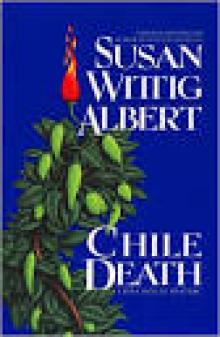 Chile Death
Chile Death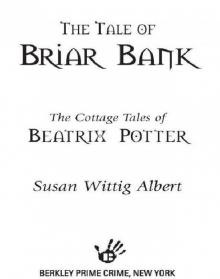 The Tale of Briar Bank
The Tale of Briar Bank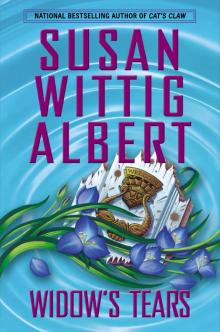 Widow's Tears
Widow's Tears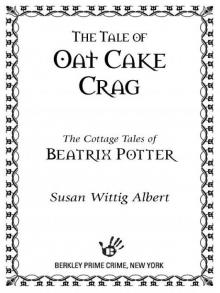 The Tale of Oat Cake Crag
The Tale of Oat Cake Crag Rueful Death
Rueful Death Bittersweet
Bittersweet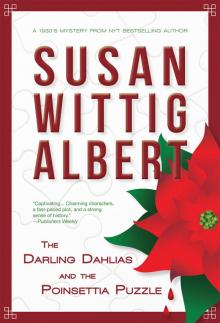 The Darling Dahlias and the Poinsettia Puzzle
The Darling Dahlias and the Poinsettia Puzzle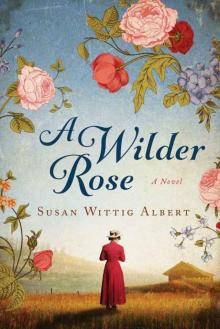 A Wilder Rose: A Novel
A Wilder Rose: A Novel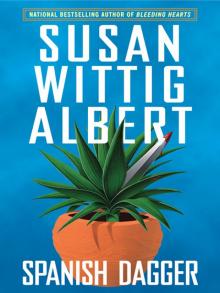 Spanish Dagger
Spanish Dagger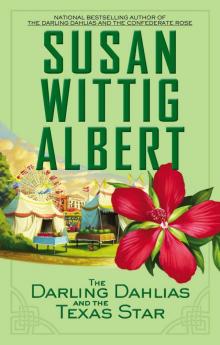 The Darling Dahlias and the Texas Star
The Darling Dahlias and the Texas Star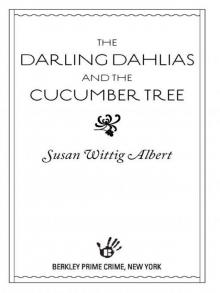 The Darling Dahlias and the Cucumber Tree
The Darling Dahlias and the Cucumber Tree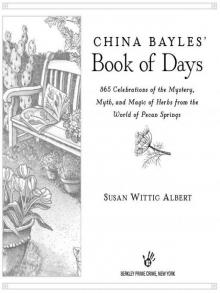 China Bayles' Book of Days
China Bayles' Book of Days Death Come Quickly
Death Come Quickly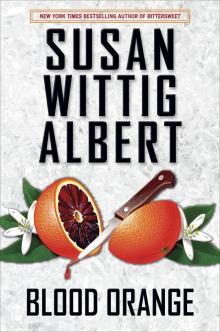 Blood Orange: A China Bayles Mystery
Blood Orange: A China Bayles Mystery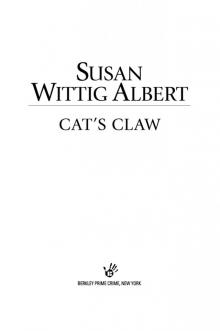 Cat's Claw
Cat's Claw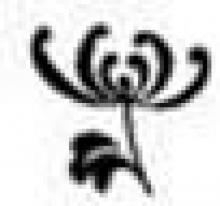 The Darling Dahlias and the Naked Ladies
The Darling Dahlias and the Naked Ladies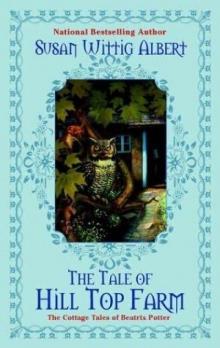 The Tale of Hill Top Farm
The Tale of Hill Top Farm The Darling Dahlias and the Confederate Rose
The Darling Dahlias and the Confederate Rose The Darling Dahlias and the Silver Dollar Bush
The Darling Dahlias and the Silver Dollar Bush The General's Women
The General's Women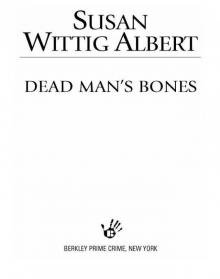 Dead Man's Bones
Dead Man's Bones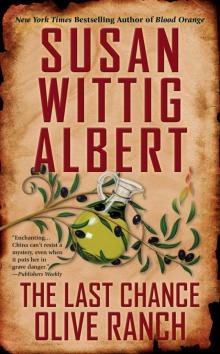 The Last Chance Olive Ranch
The Last Chance Olive Ranch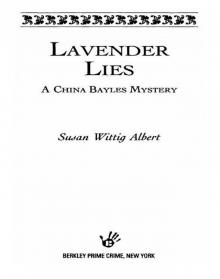 Lavender Lies
Lavender Lies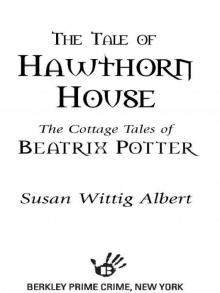 The Tale of Hawthorn House
The Tale of Hawthorn House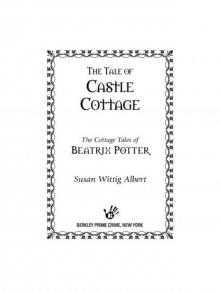 The Tale of Castle Cottage
The Tale of Castle Cottage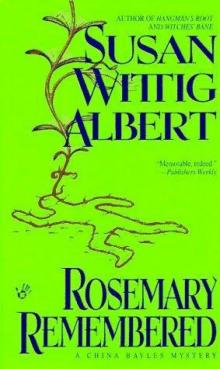 Rosemary Remembered - China Bayles 04
Rosemary Remembered - China Bayles 04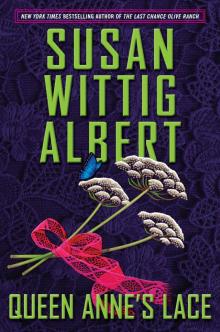 Queen Anne's Lace
Queen Anne's Lace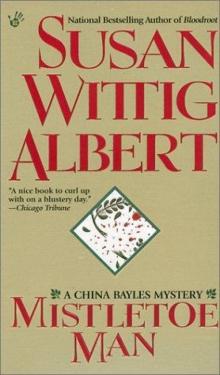 Mistletoe Man - China Bayles 09
Mistletoe Man - China Bayles 09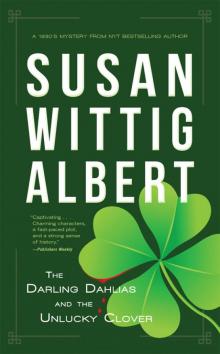 The Darling Dahlias and the Unlucky Clover
The Darling Dahlias and the Unlucky Clover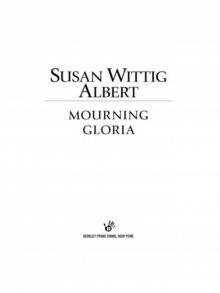 Mourning Gloria
Mourning Gloria The Darling Dahlias and the Eleven O'Clock Lady
The Darling Dahlias and the Eleven O'Clock Lady